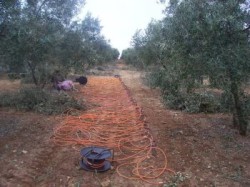Electrical methods
The electric methods in continuous current (geoelectrical) are based on the study of the spread of the electrical signal in the media. Geoelectrical methods have developed multitude of devices (Schlumberger, Wenner, dipolo-dipolo, pole-dipole...).
The aim is the knowledge of the electrical resistivities in the subsurface. It measures potential differences (M and N electrode) generated by the injection of an electric current in the subsoil (electrodes A and B). The most common geoelectric techniques in civil engineering, geotechnics, hydrogeology and environment, are the electric tomography and the vertical electrical soundings.

-
Electric tomography (ERT)has been highly developed since the arrival of the multielectrode equipments. It allows obtaining 2D sections of high resolution of real electric resistivity through the inversion of apparent resistivity pseudosections. Electrical tomographies are different levels of the traditional resistivity profilings which are inverted to be 2D models of real resistivities.

-
The vertical electrical soundings (VES allow obtaining the distribution of actual resistivity with depth at a point (1D information). They perform an inversion of apparent resistivity curves versus AB distance. Several kilometres depth can be reached, provided certain conditions are met (areas without high lateral changes, smooth topography …).
Induced polarization and self potential methods are not strictly continuous current methods, but they can be included in this section. They are linked with electrical properties of materials as they get information of electrical resistivity and chargeability of the materials.



